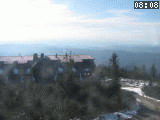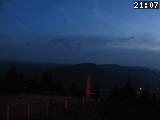Lysá hora 1323 m n. m. - královna Moravskoslezských Beskyd
Monday 26. May 2025
History of Hůrka [ History ]
The first guaranteed report of the village dates back to 1383 when Hůrka together with Jeseník were sold by lords of Kravaře to Vilém of Kortenlangen and it is also mentioned here safely in Czech as Horka. Since the 15th century the village was continuing part of demense of Starý Jičín.
The village Hůrka was independent village since 1850 in judicial and political district Nový Jičín. Typical agricultural village preserved its Czech character for the whole time. It was assigned to a parish of Starý Jičín. In private houses was taughts already since 1773, school was founded in 1863-1866 when the first school building was built. At the present time there is in the village lower degree of primary school. After Munich 1938 Hůrka fell on to Sudeten annexation although it was entirely Czech village in which no German family lived. After World War II there were built in cadaster of the village drain collectors and later gas stations of Northmoravian water supply and sewerage. On part of the territory Horecký forest is situated that was administrated by forest plant in Frenštát pod Radhoštěm. Collective farm (JZD) was in Hůrka established in 1953 and in 1972 it was connected to collective farm Jesenicko based in Jeseník nad Odrou, nowadays Agricultural cooperative society Jesenicko.
Cultural monument of the village is chapel of St. Anna from 1840.
Village sealing-stick from 1749 brought in the shield picture of standing bull accompanied in the top by three stars.
The village Hůrka was independent village since 1850 in judicial and political district Nový Jičín. Typical agricultural village preserved its Czech character for the whole time. It was assigned to a parish of Starý Jičín. In private houses was taughts already since 1773, school was founded in 1863-1866 when the first school building was built. At the present time there is in the village lower degree of primary school. After Munich 1938 Hůrka fell on to Sudeten annexation although it was entirely Czech village in which no German family lived. After World War II there were built in cadaster of the village drain collectors and later gas stations of Northmoravian water supply and sewerage. On part of the territory Horecký forest is situated that was administrated by forest plant in Frenštát pod Radhoštěm. Collective farm (JZD) was in Hůrka established in 1953 and in 1972 it was connected to collective farm Jesenicko based in Jeseník nad Odrou, nowadays Agricultural cooperative society Jesenicko.
Cultural monument of the village is chapel of St. Anna from 1840.
Village sealing-stick from 1749 brought in the shield picture of standing bull accompanied in the top by three stars.
LOCATION
- Cadastral territory: Hůrka
- Village or Town/City: Jeseník nad Odrou
- District of Administration 2: Nový Jičín
- District of Administration 3: Nový Jičín
- Region NUTS 4: Okres Nový Jičín
- Region NUTS 3: Moravskoslezský kraj
- Region NUTS 2: Moravsko-Slezsko
- Tourist region: 40 Poodří
- Destination: Severní Morava a Slezsko
INFORMATION: http://www.jeseniknadodrou.cz
Type: History
LAST MODIFY: Ivana Náplavová org. 56, 28.11.2003 v 16:24 hodin



